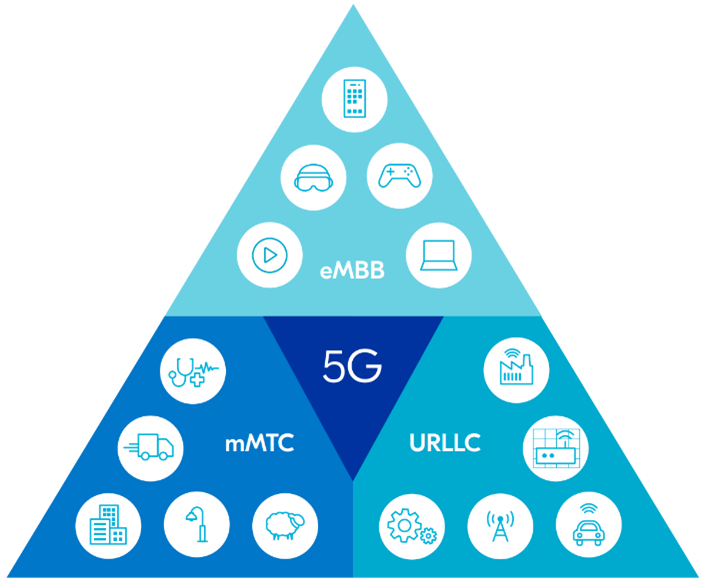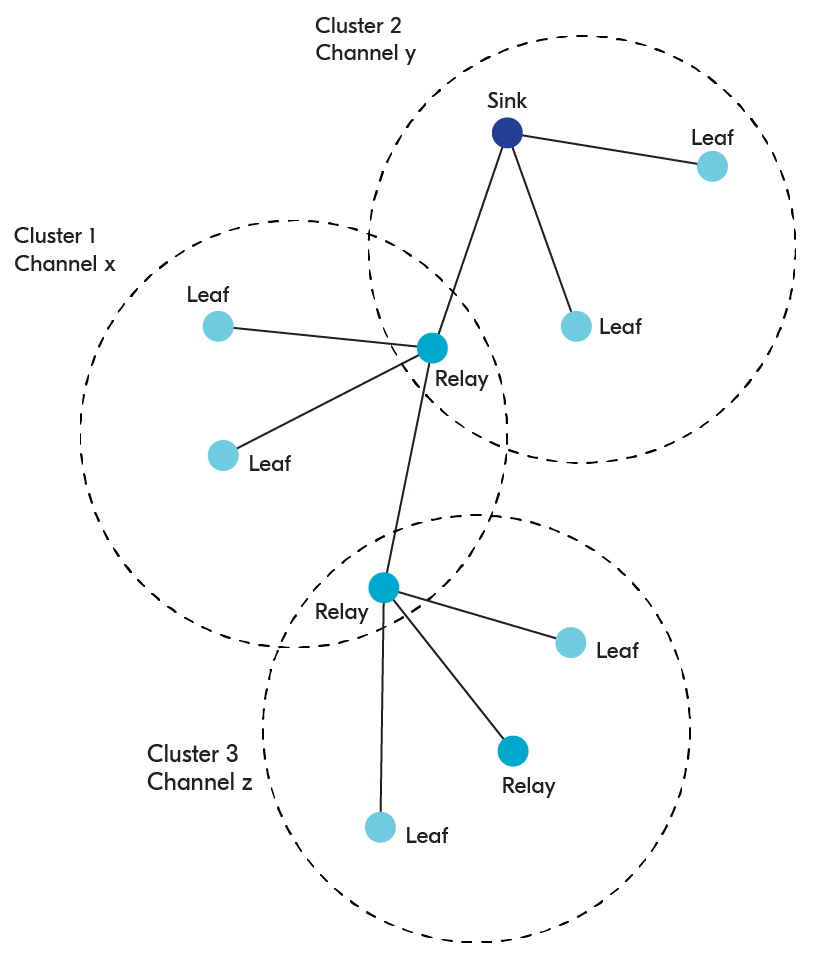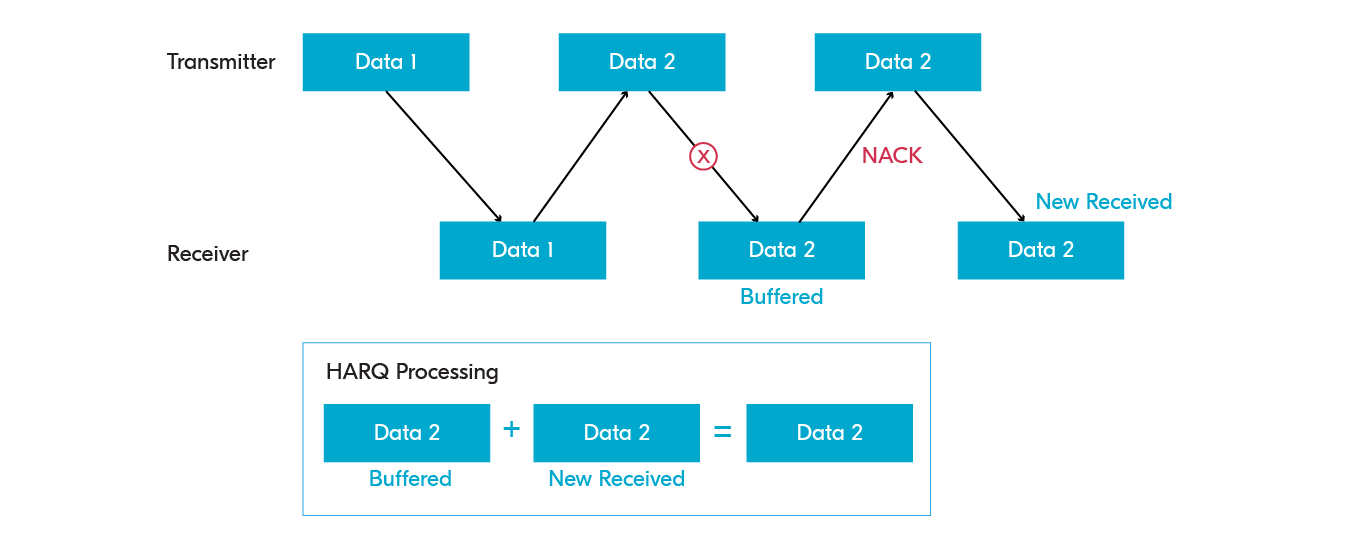The world's first non-cellular 5G technology has been getting some attention recently, ever since it was standardized by ETSI in 2020 and later adopted as a 5G standard in 2022. DECT NR+, or DECT-2020 NR as the standard is technically called, is the first-ever non-cellular technology included in the 5G standards defined by the ITU-R. The DECT NR+ standard could be the missing piece to mass adoption of the Internet of Things (IoT) by enabling license-free wireless 5G networks, where the devices form the network between them using mesh technology, and only one external connection is needed.
This blog post aims to give you a general understanding of DECT NR+, including some of its main features and application areas. We will introduce you to this new technology, including its relevancy to 5G, network topology, and frequency band. Then we will move on to some of the specific requirements that DECT NR+ fulfills in order to be a 5G standard, with regard to density, scalability, reliability, and low latency, and the specific techniques that enable this.
If you are interested in the DECT NR+ technology, make sure to register for the DECT Forum webinar series. More information can be found at the end of this blog post.
Table of Contents
A 5G technology
Back in the day, the DECT technology, which stands for Digital Enhanced Cordless Telecommunications, was used primarily in cordless telephone systems.
The development of the DECT technology is a story for another blog. In a nutshell, the DECT-2020 NR standard was developed by ETSI to meet the ITU-R's requirements for 5G technologies (formally called the IMT-2020 requirements). The 5G standard defines three separate use cases for 5G technologies to service:
- Enhanced Mobile Broadband (eMBB) - eMBB focuses on delivering significantly faster data rates and increased network capacity compared to previous generations of mobile networks.
- Massive Machine Type Communication (mMTC) - mMTC aims to connect a large number of low-power devices and sensors, and the focus here is on low power consumption, high density, and scalability.
- Ultra-Reliable Low Latency Communication (URLLC) - URLLC is intended to deliver extremely low latency and ultra-high reliability for critical communications and applications requiring real-time responsiveness and mission-critical reliability.
DECT NR+ fulfills the requirements for both mMTC and URLLC. Nordic Semiconductor has announced the commercial solution for DECT NR+, the nRF9161 SiP and the nRF9131 mini-SiP. Together with our solution partner Wirepas, our DECT NR+ offering is aimed at the mMTC market.
Network topology and terminology
DECT NR+ supports point-to-point, star, and mesh topologies. Specifically, the mesh topology is defined as a partial mesh, clustered tree topology. This means that devices are organized into individual cluster tree topologies, called clusters. A cluster tree topology is a star topology that contains branches. All clusters are connected to form the mesh network, characterized as partial mesh since all nodes are not connected to each other as in a full-mesh topology.
DECT NR+ nodes can either be a sink node, a relay node, or a leaf node. The sink is the gateway to the internet, selects the operating frequency, and initiates a beacon transmission indicating it has a route to the external world. Networks can have multiple sinks with an external connection. The relay nodes can extend the network by routing messages to other clusters and to leaf devices in their own cluster. Leaf nodes are the outmost point of the network and can only send data.
In the point-to-point and star topology, the nodes with a backhaul to the internet are defined as sink nodes, and all other nodes are characterized as leaf nodes and connected to the sink or sinks.
In the mesh topology, things are a bit more sophisticated. Device roles are appointed autonomously based on the needs of the network to support a "self-organizing" and "self-healing" topology, which can also solve congestion problems in high-traffic situations. Each device decides the next hop individually based on available routes toward the sink, meaning the clusters are formed autonomously. The image below shows an example of a DECT NR+ mesh network with one sink and three clusters operating on three different frequency channels. In cluster 3, note that the relay nodes don't necessarily have to be forwarding data - the role just indicates their ability to do so.
Frequency band
As a DECT technology, DECT NR+ has access to the license-exempt 1,9 GHz DECT band, which is globally dedicated, apart from a few areas (China, India, Japan) where efforts are undergoing by the DECT Forum.
- 1880 MHz to 1900 MHz | Europe, South Africa, much of Asia, Hong Kong, Australia, and New Zealand
- 1786 MHz to 1892 MHz | Korea
- 1880 MHz to 1895 MHz | Taiwan
- 1893 MHz to 1906 MHz | Japan, under discussion
- 1910 MHz to 1920 MHz | Brazil
- 1910 MHz to 1930 MHz | Latin America excluding Brazil
- 1920 MHz to 1930 MHz | USA & Canada
- 1880 MHz to 1930 MHz | India – Legacy DECT only now, DECT NR+ not approved yet
This allows for single products to be deployed worldwide without needing frequency planning.
DECT NR+ provides co-existence with classic DECT on the DECT band. Since DECT NR+ is made for co-existence, one can also use the ISM bands. In fact, the standard supports multiple licensed and unlicensed bands, from 450 MHz up to 6 GHz. Nordic's solution will support the classic DECT band initially.
Massive Machine Type Communication (mMTC)
As mentioned earlier, mMTC addresses the need to connect a massive amount of low-power devices and sensors. This is relevant for several areas, such as smart city, agriculture, manufacturing, and healthcare. For a technology to meet the requirements for this use-case set by the ITU-R, it must support several features, including:
- High density (1M devices per sq. km)
- Long battery life
- Asynchronous access
DECT NR+ enables highly scalable and dense networks, partly thanks to the autonomous and decentralized nature of the technology. The construction of the DECT NR+ IDs also facilitates the ability for high-density networks. The network IDs (32-bit) enable 16,7 million unique global networks and 256 overlapping networks in the same radio area. Radio device IDs (48-bit) enable 4 billion individual radio devices in a single network and 65 thousand within radio communication distance.
DECT NR+ reuses a lot of known techniques from the cellular world, for instance, something called Cyclic Prefix Orthogonal Frequency Division Multiplexing (CP-OFDM) in combination with Frequency Division Multiple Access (FDMA) and Time Division Multiple Access (TDMA) operations. These are essentially just techniques for getting the most out of the available bandwidth.
The image below illustrates this by showing the classic channel division at the top. When employing OFDM, the channel division can overlap, saving a lot of bandwidth. The resulting nominal bandwidth is scalable from 1.728 MHz up to 221.184 MHz in the standard (and for those already familiar with OFDM, the sub-carrier spacing is also scalable). This enables DECT NR+ to use minimal bandwidth, allowing for more reliable data transmission and increasing the data rate.

Devices also have autonomous dynamic power control of transmissions, varying from -40 dBm up to +23 dBm, to limit overhearing in dense networks and to achieve low power consumption. No need to scream if your neighbor is right next to you.
DECT NR+ has a unique feature set for power saving to meet the requirement for long battery life. Since relay devices manage the radio usage in their cluster, they can tell leaf nodes when the relay device can be reached for uplink data forwarding, allowing relay devices to sleep outside of this period. The relay devices page the leaf nodes in beacon messages, telling the leaf when it must listen for downlink data. The leaf node only needs to listen to beacon messages, which can have a beacon period varying from 10ms up to 32s. This allows the network to choose between very low latencies or allowing devices to sleep to save power.
Another thing to note is that DECT NR+ defines many of its core features, like routing and re-transmitting packets, on the radio stack level. This enables multi-core systems to carry out reliable radio communications without needing to wake up other cores, limiting the device's power usage.
Ultra-Reliable Low Latency Communication (URLLC)
Moving on to something different, URLLC emphasizes ultra-low latency and ultra-high reliability, intended for mission-critical communication where failure is not an option and data must be transmitted instantaneously. The URLLC use-case opens the possibility for low latency systems to consider wireless operation for the first time, delivering the same low latency and reliability previously only matched by wired connections, with applications ranging from autonomous robots, and electricity distribution to motion control and much more. A technology must fulfill numerous requirements, including:
- Ultra reliability (over 99.99% packet delivery)
- End-to-end low latency (<50ms on application layer, <1ms on the radio interface)
Let's look at how DECT NR+ meets these requirements. Regarding reliability, the physical layer of NR+ employs something called hybrid automatic repeat request (HARQ) methodology. Without going into too much detail, HARQ combines forward error correction and automatic repeat request error-control to improve the reliability of packets arriving promptly and in order. If a packet is not received or only partially received, the receiver will still buffer whatever it got and let the transmitter know to send the rest of the data. HARQ processing then combines the separate transmissions into the complete packet. This combination is handled at the physical layer, so the higher protocol layers don't need to worry about retransmissions, which also saves resources.

Relay nodes also scan the frequency channels for the least interference. They can instruct the other cluster nodes to change channels to optimize interference avoidance, achieving reliability and low latency, even in high-density networks.
Regarding the ultra-low latency requirements, there are several things to touch upon. Firstly, DECT NR+ supports multiple receiving and transmission events within the same radio frame of 10 ms. There are 24 time-divided slots for transmission in that frame. This is made possible because the time required for mode change is very low, i.e., the time it takes to go from the receiving to transmission mode. This enables DECT NR+ to meet the URLLC requirement of less than 1 ms radio layer latency in a single link. In a mesh topology, the radio links can also operate with low latency to minimize the end-to-end latency in the network.
Closing
Since its standardization in 2020, DECT NR+ has attracted significant attention. The first non-cellular technology to be incorporated as a 5G standard for both mMTC and URLLC use cases. In this blog post, we have examined what specific requirements DECT NR+ fulfills to meet the qualification and what underlying techniques and features enable this.
If you would like to learn more, Nordic has hosted two webinars about the standard, which are available to watch on demand:
In addition, the DECT Forum is hosting a webinar series dedicated to DECT NR+ this year. The first two webinars have already taken place and can be watched here:
The third webinar will take place in September, 2023. Watch this space for agenda and registration.
Enjoyed this? Subscribe to DevZone blog email notifications and be the first to know about new posts!



Top Comments